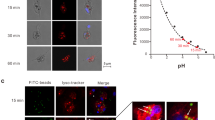Abstract
Opsonins, a group of serum proteins present in vertebrates, are known to bind to the surface of many kinds of pathogens and tag them as targets for phagocytosis. Opsonin-like molecules have been suggested to exist in several invertebrates. In this paper, we report the discovery of a new opsonin-like molecule in the coelomic fluid of the sea cucumber Holothuria leucospilota. Opsonic activity in cell-free coelomic fluid was characterized by sodium dodecyl sulfate–polyacrylamide gel electrophoresis, two-dimensional electrophoresis and gel filtration. Phagocytic uptake of yeast cells and latex beads by amoebocytes was quantified by microscopic analysis. It was found that a 20 kdalton protein bound to and enhanced phagocytosis of heat-killed yeast cells. The results of Western blot analysis suggest that both amoebocytes and spherule cells produce this opsonin-like molecule.
Similar content being viewed by others
Author information
Authors and Affiliations
Additional information
Received: 22 October 1998 / Accepted: 4 March 2000
Rights and permissions
About this article
Cite this article
Xing, J., Chia, FS. Opsonin-like molecule found in coelomic fluid of a sea cucumber, Holothuria leucospilota. Marine Biology 136, 979–986 (2000). https://doi.org/10.1007/s002270000305
Issue Date:
DOI: https://doi.org/10.1007/s002270000305




